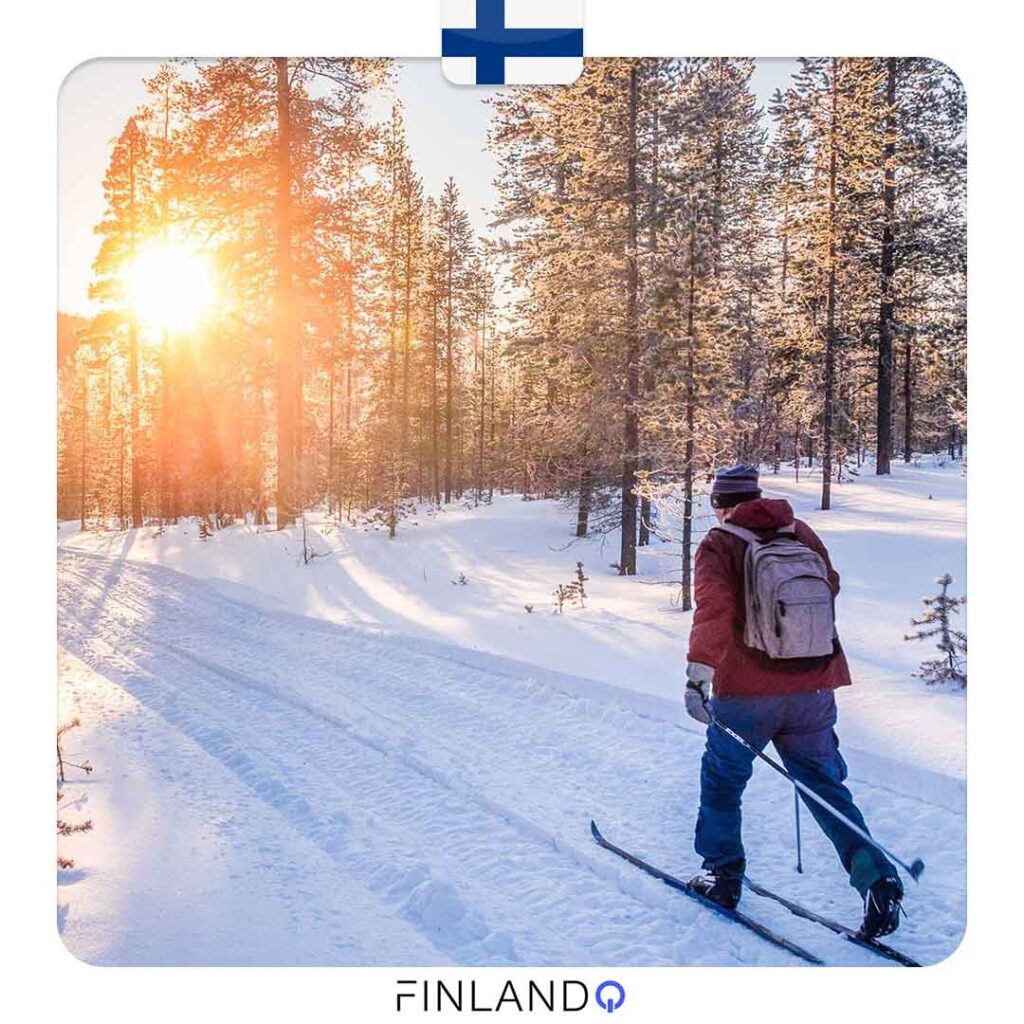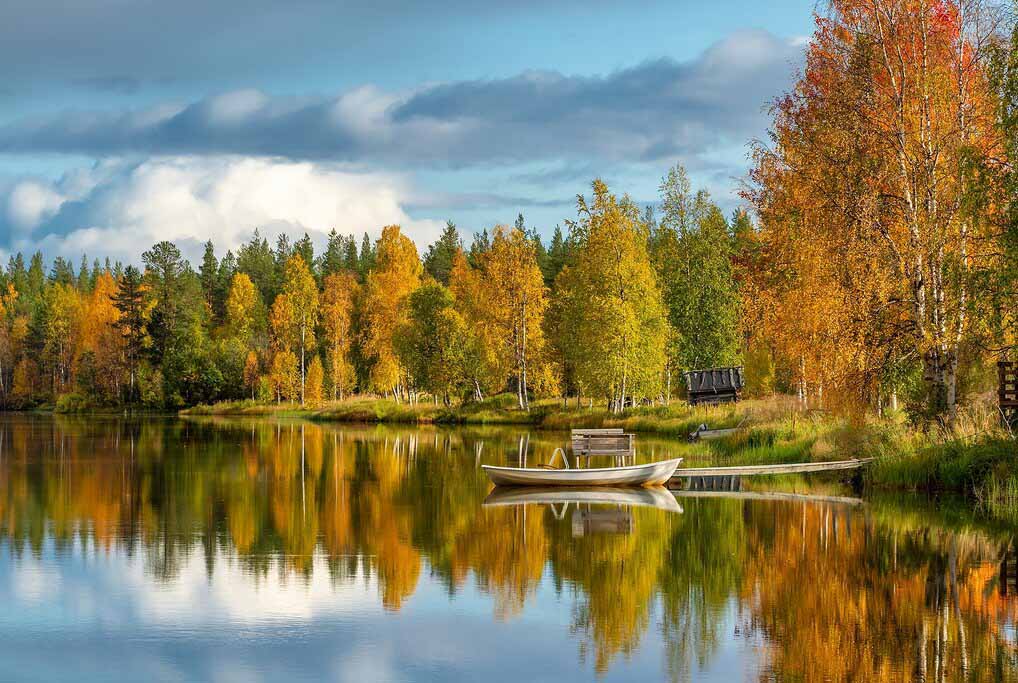When traveling or migrating to other countries, it’s essential to gather information about their climate. The weather in Finland has unique conditions that might differ significantly from what you expect. In general, Finland is one of the countries with a cold temperate climate. This cold temperate climate is more prevalent in the western and southwestern regions due to their proximity to the Baltic Sea. In the eastern and northern parts of the country, a continental climate prevails. During the summer, the continental climate can experience temperatures exceeding 30 degrees Celsius, while the south and southwest remain relatively warmer.
In the winter months, the daily maximum temperature throughout the country is below freezing. In the north, temperatures can sometimes drop below -40 degrees, while in the south, it’s around -25 degrees. The decrease in temperature is due to several weeks of polar nights in the north during which the sun doesn’t rise. The highest amount of rainfall in Finland occurs from June to October. Annual precipitation in southern Finland ranges from 600 to 700 millimeters per square meter, while it’s less in the north and northeast.
Best Times to Visit Finland:
Finland’s summer months, with long days and warm weather, are perfect for vacations and activities such as hiking or boating on its numerous lakes. However, winter also has its attractions, with abundant snow, long nights, and occasionally visible northern lights. Overall, Finland’s weather is quite diverse, as it is located in the Eurasian coastal region, experiencing both temperate and continental climates.
Finland’s weather is variable and can change rapidly, which is typical for Scandinavian regions. When the wind blows from the west, the weather is generally warm and clear in most parts of Finland. Finland is situated where warm tropical air masses and polar air masses meet, so its weather can change rapidly, especially during the winter months. It’s worth noting that Finland’s weather isn’t as cold as you might think. Temperatures are moderated by the warm Gulf Stream and the Baltic Sea.
In summer, the weather in Finland is excellent. In southern and central Finland, summer weather is moderate and warm, much like other parts of southern Scandinavia, while Finland’s winters are long and cold. In northern Finland, you can find over 90 days of snow cover each year. The mildest weather in winter is found in the southwestern archipelago among the countless islands in the Baltic Sea.
Finland’s weather also varies greatly depending on the month of travel because Finland’s weather is warmest in July and coldest in February. February is also the driest month in Finland, while August has the wettest weather of the year.
Worst Times to Travel to Finland
The worst time to travel to Finland is usually from November to March. During this period, days are short, and sunlight is weak. Tourists can experience the polar night phenomenon during the peak of the cold season in the north, and it’s the best time for those interested in observing this phenomenon. Southern regions are cold from December to February.
Popular Regions in Finland
If we rank different Finnish cities based on weather variations, the most popular ones will include:
Helsinki:
Thanks to the Baltic Sea and North Atlantic Ocean currents, Helsinki is much warmer than many people think. The average temperature in January and February is about 23 degrees Fahrenheit (-5 degrees Celsius). The snowy season in Helsinki, located in the southern part of the country, is much shorter than in other parts of Finland. Like many other places in the country, Helsinki experiences long summer days and very little sunlight in winter. The average temperature in summer is 70 degrees Fahrenheit (21 degrees Celsius).
Tampere:
Tampere is located in southern Finland and has a variable climate with a mix of continental and subarctic weather. The snowy season usually lasts from late November to early April. The average daily temperature is 62 degrees Fahrenheit (17 degrees Celsius) in July and -6 degrees Fahrenheit (21 degrees Celsius) in January.
Oulu:
Oulu is one of the northernmost major cities in the world. This city has cold and snowy winters and short, warm summers with an annual average temperature of 37 degrees Fahrenheit (3 degrees Celsius). Oulu usually receives rainfall in July and August.
Lapland, Finland:
The northernmost region of Finland has a subarctic climate with cold winters and mild summers. December to February is the best time to visit Lapland for travelers interested in seeing the Northern Lights. The average temperature in December is about 16 degrees Fahrenheit (-9 degrees Celsius), but it can sometimes drop to -22 degrees Fahrenheit (-30 degrees Celsius). The snowy season lasts from October to mid-May. Summers are warmer, with temperatures ranging from 50 to 60 degrees Fahrenheit (10 to 15 degrees Celsius).

Spring in Finland
The average temperature in Finland rises during spring, reaching about 50 degrees Fahrenheit (10 degrees Celsius) in most areas of the country. In mid-April, most of Finland experiences spring, even if there’s still snow in the northern regions. Lakes usually thaw in Finland’s interior areas by May, making outdoor activities more enjoyable.
Summer in Finland
Summer is another pleasant season in Finland. In the southern and central regions, summer weather is similar to other parts of southern Scandinavia, with moderate and warm conditions. July is the warmest month to visit, with long daylight hours. During the “white nights” of summer, you can experience over 20 hours of daylight. However, be aware that even in summer, Finland can be cool. It’s a good idea to have some warmer clothing with you.
Autumn in Finland
In the autumn season, it’s not unusual to see snowfall in northern Finnish cities. High winds and chill are possible until November. October to December is also cold and rainy, with temperatures near or below freezing in the north. This is not the ideal time to visit Finland. The temperatures decrease significantly in the autumn, and this season can even bring snow in specific regions of the country. It’s advisable to wear waterproof clothing, a heavy coat, gloves, a scarf, and a hat.
Winter in Finland
Winters in Finland are snowy, humid, and cold. Lapland experiences snowy weather from October to May, while southern Finland is somewhat milder, enduring around four to five months of winter. Despite the cold weather, winter is one of the most popular times to visit Finland. Travelers flock to the country’s many ski resorts and engage in winter activities such as dog sledding and ice fishing.
Northern Lights and Midnight Sun in Finland
Finland boasts several unique natural phenomena that will captivate any traveler. The midnight sun during the summer leads to nearly continuous daylight, meaning the sun doesn’t set, and it remains bright all day long. Conversely, Finland also experiences polar nights during which specific areas remain in perpetual darkness during the winter months.
Finland, especially Lapland, is a popular destination to witness the Northern Lights, also known as the Aurora Borealis. This colorful natural light display is observable on nearly 200 nights per year in Finland. Some accommodations even offer glass-roofed rooms that allow you to lie back and enjoy the Northern Lights comfortably.
Hazards of Finland’s Weather
Finland faces weather-related risks, primarily including snowstorms, floods, and blizzards. Flooding mostly occurs during the spring when snow begins to melt. Ice dams in many areas lead to winter flooding. In 2013, flooding caused ten million euros in damages across various regions. Flooding is generally the primary cause of residential displacement and property destruction in Finland. Large winter storms often render roads impassable. Visibility during blizzards is poor, and there are several incidents of damage to power lines due to fallen trees. Storms disrupt everyday life by causing disruptions in air traffic, trains, and more, making road travel hazardous.

Finland’s Weather in Different Months
Weather in Finland : January
– The coldest month in Finland, with both cold days and nights. The Northern Lights can be observed on very cold days. The average temperature in Ivalo and Rovaniemi in northern Lapland ranges from -17.8°C to -7.8°C.
– February
– February remains cold in Finland with slight increases in temperature and daylight. The average temperature in the north ranges from -17.2°C to -7.8°C, while the south varies from -8.3°C to -0.6°C.
– March
– March continues to be a cold winter month in Finland, with most areas still covered in snow. Snow depth often reaches its highest in this month. The average temperature in Helsinki ranges between -3.9°C and 2.2°C, with most nights below freezing.
– April
– April marks the beginning of spring in southern Finland, Åland, and the southwestern archipelago. Spring lasts 45 days in the north and 65 days on the southern coasts. The average daily temperature ranges from 0°C to 8.9°C, with over 7 hours of daily sunshine.
– May
– May brings spring to the northernmost parts of Lapland. Days are mild in most areas, but nights remain frosty. The average temperature in Rovaniemi varies from 0°C to 13.9°C, with clear skies on 45% of days.
– June
– June marks the start of a beautiful summer in Finland, with warm days and chilly nights. The average daily temperature stays consistently above 10°C throughout the season, and sunshine lasts for over 9 hours each day.
Weather in Finland: July
July is typically the warmest month in Finland as temperatures across the country rise significantly. The heatwave occurs during the peak of summer, but it rarely lasts for more than 8 consecutive days.
Weather in Finland in August
August is the wettest month in Finland, with an average precipitation of 76.2 millimeters (3 inches) in most areas. The average temperature in Helsinki and Turku ranges from 12.8°C to 20°C with 9 hours of daily sunshine.
Weather in September
September marks the short autumn season in Finland, with daily average temperatures ranging from 4.4°C to 10°C.
Weather in October
October signals the onset of cold winter in many parts of Finland. Nights in most regions of the country, except the south, fall below freezing. Oulu records cold temperatures ranging from 1.1°C to 6.1°C and experiences 45.7 millimeters (1.8 inches) of precipitation.
Weather in November
In November, daylight lasts for almost 1 hour daily, as the sky remains mostly cloudy 70% to 80% of the time. Daylight hours reduce to less than 4 hours near the Arctic Circle and to 6.5 hours in the south and west.
Weather in December
December represents the peak of winter in Finland, with temperatures consistently below freezing throughout the day and night. The sky is cloudy between 71% and 85% of the time, and many lakes, rivers, and seas are often frozen.












